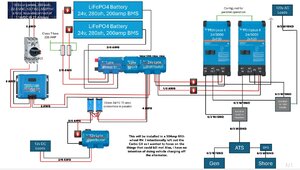Hello all,
This may be my first post on this forum not really sure, I've been lurking and learning for so long I can't remember if I have posted anything. So here goes, I have uploaded a diagram of my Victron install for the competent and highly educated masses to peruse and provide constructive criticism (with an eye on not letting this guy burn down his fifth wheel).
Let me thank you all in advance for even reading this far much less actually looking at the diagram and providing feedback, I know your time is valuable and unreturnable.
V/R
Jeff
This may be my first post on this forum not really sure, I've been lurking and learning for so long I can't remember if I have posted anything. So here goes, I have uploaded a diagram of my Victron install for the competent and highly educated masses to peruse and provide constructive criticism (with an eye on not letting this guy burn down his fifth wheel).
Let me thank you all in advance for even reading this far much less actually looking at the diagram and providing feedback, I know your time is valuable and unreturnable.
V/R
Jeff



